Lincrusta-Walton
and Other 19th-century Raised Relief Wall Coverings
Helena Brazil and Paul Croft
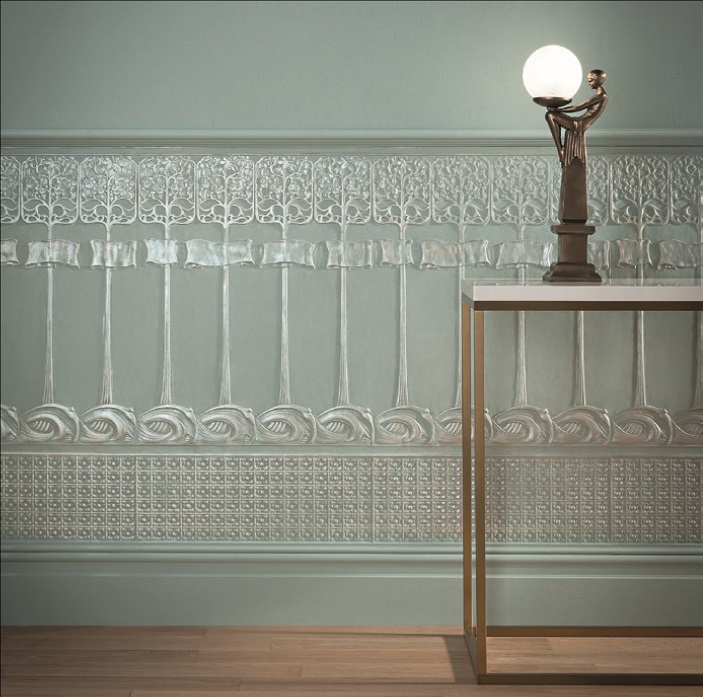 |
|
| An authentic Art Nouveau style of Lincrusta installed and decorated by Lincrusta technical manager, Andy Sarson. (Photo: courtesy of LINCRUSTA®) |
Lincrusta-Walton a raised relief wallcovering still found in excellent condition in many homes and buildings, having endured far beyond the expected lifespan of other forms of applied decoration such as wallpaper, paint and textiles. It was one of several innovative wall and ceiling coverings manufactured in the late 19th century to imitate the rich surface patterns and textures of earlier centuries, including fine plaster wall and ceiling mouldings, timber panelling and embossed leather wall decorations. The leading manufacturers employed the skills of well-known freelance designers such as George Haité, Lewis F Day, Owen W Davis and Dr Christopher Dresser to reflect current fashion, and surviving examples provide us a valuable insight into the interior design and decorating trends of the period.
Today, Victorian wall coverings are often under-appreciated, but conservation projects are under way to restore lost areas of Lincrusta-Walton and other raised relief wallpapers such as Cordelova, and to preserve these schemes for posterity.
THE HISTORY OF LINCRUSTA-WALTON
Lincrusta takes its name from the Latin ‘linum’, meaning flax (linseed), and ‘crusta’, meaning relief or embossed. When a pot of linseed oil paint is left without its top on, the surface quickly forms a thin film which gradually thickens as short molecules of oil cross-link to create long molecular chains, a process known as polymerisation. It is these long molecular chains which give paint and modern plastics their strength and resilience.
Frederick Walton may not have understood the chemistry involved, but he recognised the significance of the skin and its potential. His experiments led him to dip panes of glass repeatedly into linseed oil, allowing them to dry between applications. He later perfected the process of drying by painting the linseed oil on to stretched, pre-prepared cloths. The oxidised oil cloth was then broken down and a small amount of shellac added before the mixture was thoroughly kneaded in hot mixing vats, creating a material not unlike rubber. The addition of naphtha, a distillate of coal, created the material more closely resembling that of the India rubber Walton was searching for, and by early 1863 he had recognised that his newly patented material could be rolled directly onto a backing fabric in a single pass through mechanised rollers.
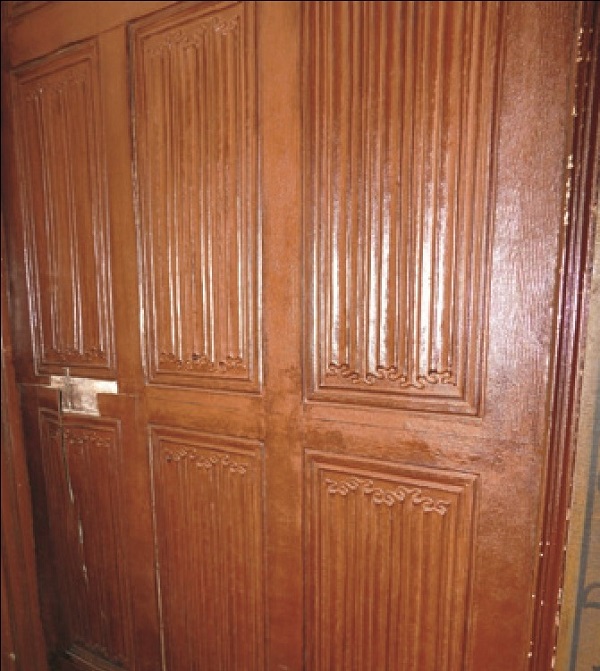 |
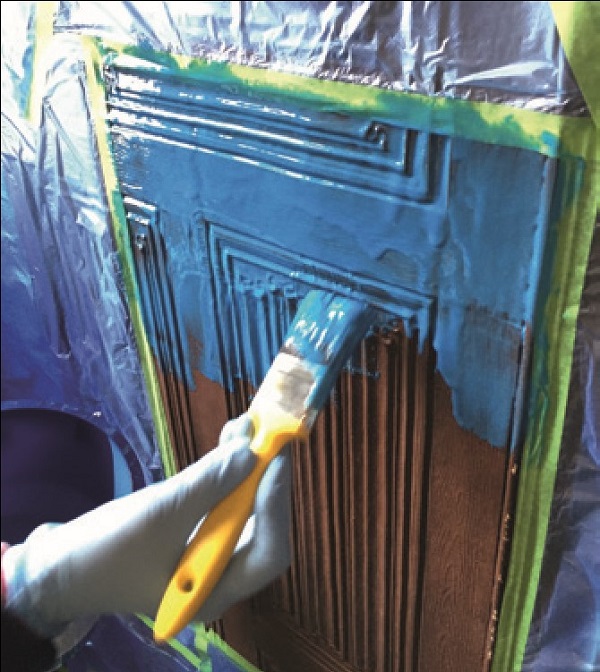 |
| An example of damage to an original panel before treatment. | Moulding material being pasted onto an original panel. |
The discovery was first used by Walton to develop floor coverings, and the Linoleum Manufacturing Company began production in Chiswick in July 1864. An adaptation of the process led to the development of an embossed wall covering known as Lincrusta Muralis when it was patented in 1877, but it was renamed Lincrusta-Walton in 1880.
The principal ingredients of both lincrusta and linoleum is thus polymerised linseed oil, termed linseed oil ‘putty’, combined with various other resins, driers and fillers and bound by a backing fabric.
For Lincrusta the linseed oil putty is embossed or imprinted by rollers which apply pressure to create the design, and adheres the embossed sheet to a backing fabric of hessian or paper. Unlike linoleum, Lincrusta-Walton does not require long periods to cure and can be hung on the wall almost immediately. Modern day Lincrusta® ingredients have been slightly changed, enabling the material to meet British fire regulations to Class B, s2-d0 under BS EN15102:2007. Lincrusta-Walton in its long history has been manufactured all over the world. Joseph Musnier purchased the patents to replicate it in 1880 and manufactured at Pierrefitte near Paris. The Lincrusta-Walton Manufacturing Company began trading in the USA in 1883 after building a large manufacturing plant in Stamford, Connecticut. Frederick Beck, manager of the Stamford business, purchased the company in around 1890 and renamed it Fr Beck and Co. Lincrusta-Walton was also manufactured under licence in the 20th century in Germany and Italy.
OTHER RAISED RELIEF WALL COVERINGS
Lincrusta-Walton is not strictly a wallpaper as it is made from linseed oil and various fillers. It is frequently confused or categorised with other raised relief materials made from paper such as Lignomur, Anaglypta, Cameoid and Calcorian, all of which are manufactured using distinctly different processes.
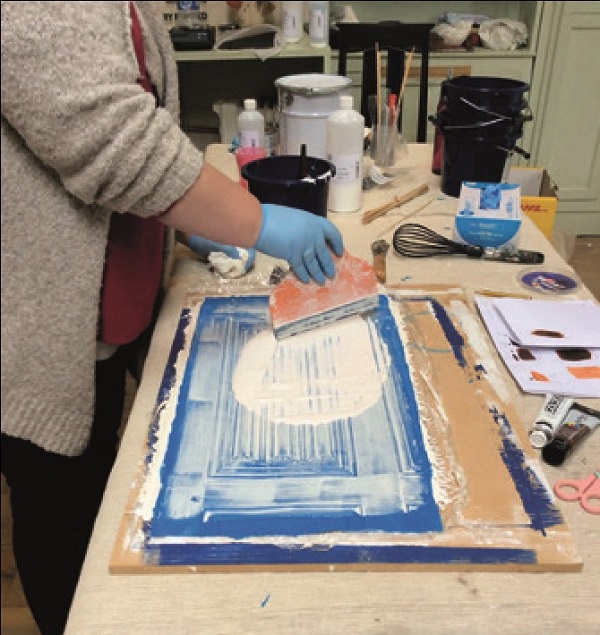 |
|
| A replacement panel being prepared in a mould. | |
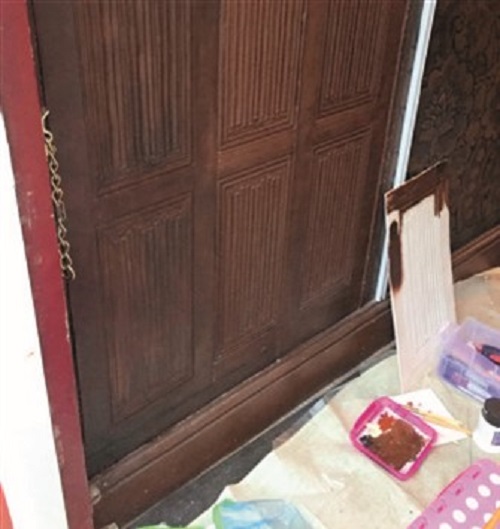 |
|
| A replacement panel being fitted and painted. (All photos: Lincoln Conservation) |
Tynecastle Tapestry is the earliest raised
relief wallpaper, conceived in 1874 and later
refined in a series of patents by Morton & Co between 1882–1896. It is a hand-moulded compound of canvas and paste utilised to
create texture, most notably that of leather.
Lignomur is an American wood-fibre pulp wall and ceiling decoration, impressed and coloured with wood blocks. Invented in 1880 and introduced in England in 1886, the recipe changed to a production that used rag pulp. The company was purchased in 1896 by Allan, Cockshut & Co, before transferring ownership to the Wallpaper Manufacturing Company (WPM) in 1899.
Anaglypta was patented by Thomas J Palmer the former London manager of Lincrusta-Walton. Manufactured using paper pulp which was embossed before drying, the name Anaglypta is derived from the Greek ‘ana’ meaning raised and ‘glypta’ which means carving. Manufacture was initially undertaken by Storey Brothers in Lancaster in 1888. The business passed through ownership by C & J G Potter & Company before being acquired by the WPM in 1899.
Caméoid, adapted from the word ‘cameo’, is a hollow-backed, lightweight pressed white paper in bas relief. The product was invented in 1888 by the Lincrusta-Walton manager, D M Sutherland, but it was not marketed by the directors at Lincrusta-Walton until 1898.
Calcorian was invented in 1892 and sold by the Calcorian Wall & Ceiling Decoration Manufacturers. Made from a composition of cork dust and rubber, it was spread on to paper before passing through a calendering machine which utilised hard-pressure rollers.
Salamander is a wall and ceiling decoration invented in c1895 and marketed by The United Asbestos Co Ltd. The highrelief material was made from wet asbestos pulp using flat pattern plates and the low relief material was made from asbestos paper embossed using hydraulic pressure.
Cordelova was initially produced in the late 19th century by the Edinburgh firm Brown, which manufactured this high-relief paper by hand. Softened white paper was beaten into the recesses of cast iron moulds using suitable brushes, with a corresponding roller slowly revolved over the surface to press out the design. Two layers of paper were used, a front paper and a back, which formed a lightweight duplex material that could be formed into very high-relief designs.
Raised relief wallcoverings were at their zenith during the latter 19th and early 20th century, however their popularity has declined in more recent decades. Changing fashion, budgets and taste has seen the loss of thousands of designs created by some of the world’s most renowned designers, but there are still a few surviving examples. Considerable care and attention is now being given by conservators to protect those that remain before they are lost.
THE RESTORATION OF LINCRUSTA WALTON PANELS AT THE DAVID PARR HOUSE
Lincoln Conservation was recently invited to restore the original Lincrusta-Walton panels at the David Parr House in Cambridge, a small, three-bedroomed house bought in 1886 by David Parr, an artisan painter and decorator who replicated within his own home the Gothic Revival and Arts and Crafts decorative work he undertook for F R Leach & Sons. According to the David Parr House website, this firm of master decorators and craftsmen was employed on some of the city’s most significant architectural projects, including Queens’ College and Jesus College, working with such distinguished figures as the architect George Frederick Bodley, and the designer William Morris. David Parr kept a diary of all his decorative work in the house and the entry for the Lincrusta-Walton hallway panels can be found on page 20:
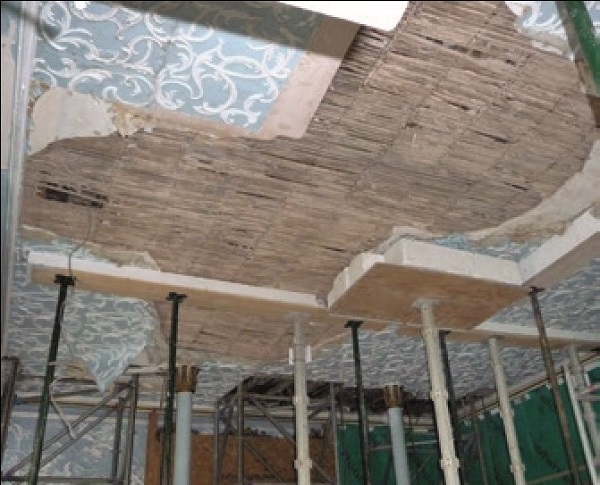 |
||
| The damaged Cordelova ceiling at the Crescent, Buxton. (All photos: Lincoln Conservation) |
Entrance Hallway ‘A portion of the dado canvas cut away where rotted near front door. The plaster knocked off & splines let into brick joints and the match boards fixed after three times painting the sides next the wall & once painted the outer side with red lead & varnish. Then ordinary scrim canvas tacked on & coated with glue size & plaster then the LincrustaWalton panels stuck on with thick paste & stopped up with putty. & finished off December 1904. The Lincrusta panels were taken off a room dado in 1898 Mr Foxwells House.’
It is believed the hallway design was created by David Parr from many small offcuts pieced together from an original 19th-century Lincrusta-Walton design, no.1128 Hampton Court. The panels were originally 18 inches wide and could be purchased for 2s 9d from wholesalers, with the earliest reference within catalogues found in 1898, where it was described as sold in ‘cedar’ or ‘B’, a chocolate or warm brown colour.
Student conservators from the University of Lincoln, working with the guidance of the current manufacturers, Heritage Wallcoverings Ltd, restored two of the six small panels to the left of the front door below dado height, which had over the past century begun to curl and break away from the wall. The replication process involved making a reinforced silicone mould taken from one of the intact panels. From this mould, very thin casts of the relief were made in a composite of gypsum suspended in an acrylic resin. Once partially cured, the replicated panels were cut to size and attached to the wall using a strong adhesive, then filled and colour-matched to the rich dark chocolate brown of the original Lincrusta-Walton.
THE RESTORATION OF CORDELOVA CEILING PANELS AT THE CRESCENT, BUXTON
Another recent undertaking by Lincoln Conservation, is the reproduction of raised relief decorative papers, Cordelova, at The Crescent in Buxton.
Originally designed by architect John Carr and built in 1780, this Grade I listed building later became a hotel, assembly room and five lodging houses before being converted for use by the local authority in the 1970s. It is currently undergoing a major programme of restoration, due for completion in 2019, funded in partnership by the Heritage Lottery Fund, Buxton Crescent & Thermal Spa Co Ltd, the local authority and Historic England. The work includes the replication of a substantial number of Cordelova panels (each measuring 30 by 24 inches) attached to one of the ceilings.
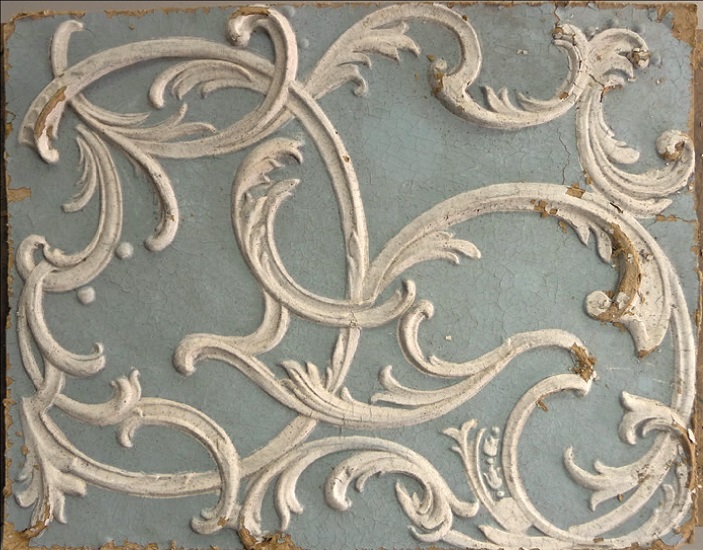 |
||
| A section of original Cordelova before restoration. |
Unfortunately, the lath and plaster ceiling is in a poor state with approximately half its surface area fallen away, exposing some of the floor joists in the room above. The surviving plaster and panels will be retained, consolidated and further secured, with new plaster reinstated to provide seamless repairs to the original material. Approximately 70 new substitute panels will be reproduced, using materials compatible with the original composition and in line with best conservation practice.
Traditionally, the reproduction of a three-dimensional surface such as this would be achieved by using a suitable moulding material and producing a cast, potentially from fibreglass or other similar material from the mould. However, the surface of the panels was covered in a thick layer of peeling and crazed paint. Any resultant mould taken would have lacked crisp definition and included all the surface blemishes that had developed over time.
It was therefore decided that the creation of a mould using a contactless method was far more appropriate, minimising the risk to the existing panels and allowing the resultant digital file to be cleaned using computer software to remove all imperfections. A single panel in good condition was selected and scanned using an Artec Eva 3D white-light scanner, with 3D point accuracy of up to 0.1mm. This created a polygon mesh from the point cloud data, representing the geometry that was in the line of sight of the scanner. The polygon mesh then embedded a colour signal that created a three-dimensional full colour representation of the scanned object. The resulting file was then exported to two different CAD packages which helped recreate a precise geometry suitable for export to a computer-controlled flatbed router. The router was then used to create a positive pattern, faithfully reproducing the contours and dimensions of the original panel.
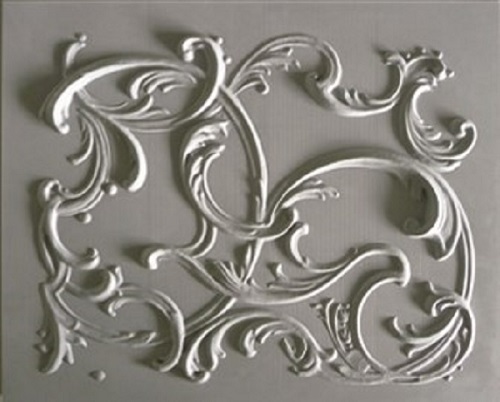 |
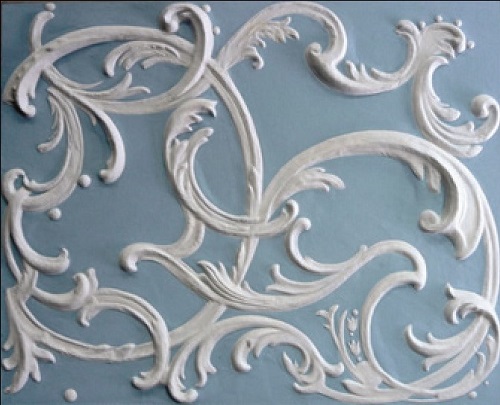 |
| The new mould prepared with a computer-controlled flatbed router from 3D scans. | A new painted panel on plasterboard. |
With the positive mould created, a corresponding mould was cast in flexible addition cure silicon rubber and utilised as the master mould to create the required number of new panels. Following exhaustive trials to finalise the materials required to produce a robust, flat and aesthetically suitable panel, brown unglazed parcel paper and D4 waterproof PVA adhesive were used to create the embossed paper design. The raised relief was further strengthened with Jesmonite AC100, an acrylic polymer and mineral resin, to stiffen and add robustness to the raised design.
Further Information
- D Gonzalez, C Cogdell, ‘The raw materials of the linoleum life cycle’, Design Life-cycle, 2014 (www.designlife-cycle.com/linoleum/)
- Lincrusta, ‘History’, Lincrusta: the ultimate wallcovering since 1877, (https://lincrusta.com/our-history/)
- Brazil, H, Lincrusta 1877–1887: The Development, Designs and Character of Lincrusta-Walton, MA in Conservation by Research (unpublished). University of Lincoln, 2018
- A V Sugden, J L Edmondson, A History of English Wallpaper 1509–1914, London: Batsford Ltd, 1924
- P H Simpson, Perspectives in Vernacular Architecture, vol.7, Exploring Everyday Landscapes, Linoleum and Lincrusta: The Democratic Coverings for floors and walls, Vernacular Architecture Forum, 1997
- T C Jester, Twentieth Century Building Materials: History and Conservation, Getty Conservation Institute, US, 2014
- C Oman, J Hamilton, Wallpapers A History and Illustrated Catalogue of the Collection in the Victoria and Albert Museum, Sotheby Publications, 1982
- L Hoskins, The Papered Wall History, Pattern, Technique, Thames & Hudson Ltd, 1994



